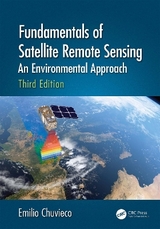
Fundamentals of Satellite Remote Sensing
Productivity Press (Verlag)
978-1-4987-2805-8 (ISBN)
- Titel erscheint in neuer Auflage
- Artikel merken
The book begins with an introduction to the basic processes that ensure the acquisition of space-borne imagery and provides an overview of the main satellite observation systems. It then describes visual and digital image analysis, highlights various interpretation techniques, and outlines their applications to science and management. The latter part of the book covers the integration of remote sensing with GIS for environmental analysis.
Based on the first English version published in 2010, this latest edition has been written to reflect a global audience, and factors in international debates and legal issues surrounding EO, as well as future developments and trends.
New in the Second Edition:
Includes additional illustrations now in full color
Uses sample images acquired from different ecosystems at different spatial resolutions to illustrate different interpretation techniques
Updates information on recent satellite missions (Landsat-8, Sentinel-2, hyperspectral and hyperspatial programs)
Covers near-ground missions (including UAV) and ground sensors (spectro-radiometers, cameras, LIDAR, etc.) to support EO analysis
Offers analysis of image spatial properties
Presents material on visual analysis, time series analysis, and data fusion
Provides examples of EO data that cover different environmental problems, with particular relevance to global observation
Fundamentals of Satellite Remote Sensing: An Environmental Approach, Second Edition details the tools that provide global, recurrent, and comprehensive views of the processes affecting the Earth and is a must-have for researchers, academics, students, and professionals involved in the field of environmental science.
Emilio Chuvieco is a professor of geography and director of the Environmental Ethics chair at the University of Alcalá, Spain. He was a visiting professor at the University of California at Berkeley and Santa Barbara, the Canadian Remote Sensing Center, Cambridge University, and the University of Maryland. In addition, he is science leader of the Fire Disturbance project within the European Space Agency’s Climate Change Initiative program. He has coauthored 330 papers and book chapters, and 23 books. He has advised 35 Ph.D. dissertations. He is currently co-editor-in-chief of the journal Remote Sensing of Environment
Introduction
Definition and Objectives
Historical Background
International Space Law
Benefits of Environmental Monitoring from Satellite Sensors
Sources of Information on Remote Sensing Data
Review Questions
Physical Principles of Remote Sensing
Fundamentals of Remote Sensing Signals
Electromagnetic Spectrum
Terms and Units of Measurement
Electromagnetic Radiation Laws
Spectral Signatures in the Solar Spectrum
Thermal Infrared Domain
Microwave Region
Atmospheric Interactions
Review Questions
Sensors and Remote Sensing Satellites
Resolution of a Sensor System
Passive Sensors
Active Sensors
Satellite Remote Sensing Missions
Review Questions
Basis for Analyzing EO Satellite Images
Constraints in Using Remote Sensing Data
Types of Interpretation
Organization of Remote Sensing Project
Interpretation Phase
Presentation of Study Areas
Review Questions
Visual Interpretation
Characteristics of Photographic Images
Feature Identification
Criteria for Visual Interpretation
Elements of Visual Analysis
Review Questions
Digital Image Processing (I): Enhancements and Corrections
Structure of a Digital Image
Media and Data Organization
Digital Image Processing Systems
General File Operations
Visual Enhancements
Geometric Corrections
Radiometric Corrections
Image Fusion Methods
Review Questions
Digital Image Processing (II): Generation of Derived Variables
Generation of Continuous Variables
Digital Image Classification
Techniques of Multitemporal Analysis
Analysis of Spatial Properties
Review Questions
Validation
Relevance of Validating Results
Sources of Error
Methods to Estimate Accuracy
Sampling Design
Gathering Information
Validating Interval-Scale Variables
Validating Classified Images
Review Questions
Remote Sensing and Geographic Information Systems
Trends in GIS and Remote Sensing Development
GIS as Input for RS Interpretation
RS as Input for GIS
Integration of Satellite Images and GIS
Review Questions
Appendix
References
| Erscheinungsdatum | 25.05.2016 |
|---|---|
| Zusatzinfo | N/A; 39 Tables, color; 267 Illustrations, color |
| Verlagsort | Portland |
| Sprache | englisch |
| Maße | 156 x 235 mm |
| Gewicht | 975 g |
| Themenwelt | Naturwissenschaften ► Geowissenschaften ► Geografie / Kartografie |
| Technik ► Nachrichtentechnik | |
| ISBN-10 | 1-4987-2805-7 / 1498728057 |
| ISBN-13 | 978-1-4987-2805-8 / 9781498728058 |
| Zustand | Neuware |
| Informationen gemäß Produktsicherheitsverordnung (GPSR) | |
| Haben Sie eine Frage zum Produkt? |
aus dem Bereich



